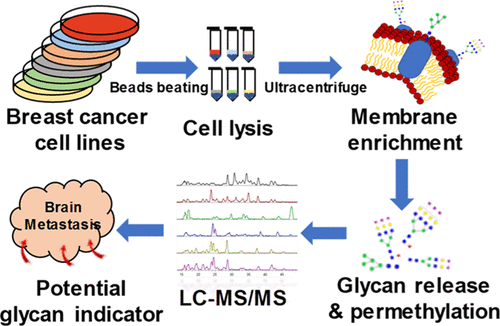当前位置:
X-MOL 学术
›
J. Proteome Res.
›
论文详情
Our official English website, www.x-mol.net, welcomes your
feedback! (Note: you will need to create a separate account there.)
Comparative Membrane N-Glycomics of Different Breast Cancer Cell Lines To Understand Breast Cancer Brain Metastasis.
Journal of Proteome Research ( IF 3.8 ) Pub Date : 2019-12-26 , DOI: 10.1021/acs.jproteome.9b00664 Wenjing Peng 1 , Parvin Mirzaei 1 , Rui Zhu 1 , Shiyue Zhou 1 , Yehia Mechref 1
Journal of Proteome Research ( IF 3.8 ) Pub Date : 2019-12-26 , DOI: 10.1021/acs.jproteome.9b00664 Wenjing Peng 1 , Parvin Mirzaei 1 , Rui Zhu 1 , Shiyue Zhou 1 , Yehia Mechref 1
Affiliation

|
The mechanism of brain metastatic breast cancer has gained attention because of its increased incidence rate and its low survival rate. Aberrant protein glycosylation is thought to be a contributing factor in this metastatic mechanism, in which metastatic cancer cells can pass through the blood-brain barrier (BBB). The cell membrane is the outermost layer of a cell and in direct contact with the environment and with other cells, making membrane glycans especially important in many biological processes that include mediating cell-cell adhesion, cell signaling, and interactions. Thus, membrane glycomics has attracted more interest for a variety of disease studies in recent years. To reveal the role that membrane N-glycans play in breast cancer brain metastasis, in this study, membrane enrichment was achieved by ultracentrifugation. Liquid chromatography-tandem mass spectrometry was employed to analyze enriched membrane N-glycomes from five breast cancer cell lines and one brain cancer cell line. Relative quantitative glycomic data from each cell line were compared to MDA-MB-231BR, which is the brain-seeking cell line. The higher sialylation level observed in MDA-MB-231BR suggested the importance of sialylation as it might assist with cell invasion and the penetration of the BBB. Some highly sialylated N-glycans, such as HexNAc5Hex6DeoxyHex1NeuAc3 and HexNAc6Hex7DeoxyHex1NeuAc3, exhibited higher abundances in 231BR, indicating their possible contributions to breast cancer brain metastasis as well as their potential to be indicators for the breast cancer brain metastasis.
中文翻译:

比较不同的乳腺癌细胞系的膜N-糖原,以了解乳腺癌的脑转移。
脑转移性乳腺癌的发病机制由于其发病率增加和生存率低而受到关注。异常的蛋白质糖基化被认为是这种转移机制的一个促成因素,其中转移性癌细胞可以穿过血脑屏障(BBB)。细胞膜是细胞的最外层,与环境和其他细胞直接接触,这使得膜聚糖在许多生物过程中特别重要,这些过程包括介导细胞与细胞的粘附,细胞信号传导和相互作用。因此,近年来,膜糖组学引起了对多种疾病研究的更多兴趣。为了揭示膜N聚糖在乳腺癌脑转移中的作用,在这项研究中,通过超速离心实现了膜的富集。液相色谱-串联质谱法用于分析来自五种乳腺癌细胞系和一种脑癌细胞系的富集膜N-糖基。将来自每个细胞系的相对定量血糖数据与寻求大脑的细胞系MDA-MB-231BR进行了比较。在MDA-MB-231BR中观察到较高的唾液酸化水平表明了唾液酸化的重要性,因为它可能有助于细胞侵袭和BBB的渗透。一些高度唾液酸化的N-聚糖,例如HexNAc5Hex6DeoxyHex1NeuAc3和HexNAc6Hex7DeoxyHex1NeuAc3,在231BR中表现出更高的丰度,表明它们可能对乳腺癌脑转移有贡献,并且有可能成为乳腺癌脑转移指标的潜力。
更新日期:2020-01-13
中文翻译:

比较不同的乳腺癌细胞系的膜N-糖原,以了解乳腺癌的脑转移。
脑转移性乳腺癌的发病机制由于其发病率增加和生存率低而受到关注。异常的蛋白质糖基化被认为是这种转移机制的一个促成因素,其中转移性癌细胞可以穿过血脑屏障(BBB)。细胞膜是细胞的最外层,与环境和其他细胞直接接触,这使得膜聚糖在许多生物过程中特别重要,这些过程包括介导细胞与细胞的粘附,细胞信号传导和相互作用。因此,近年来,膜糖组学引起了对多种疾病研究的更多兴趣。为了揭示膜N聚糖在乳腺癌脑转移中的作用,在这项研究中,通过超速离心实现了膜的富集。液相色谱-串联质谱法用于分析来自五种乳腺癌细胞系和一种脑癌细胞系的富集膜N-糖基。将来自每个细胞系的相对定量血糖数据与寻求大脑的细胞系MDA-MB-231BR进行了比较。在MDA-MB-231BR中观察到较高的唾液酸化水平表明了唾液酸化的重要性,因为它可能有助于细胞侵袭和BBB的渗透。一些高度唾液酸化的N-聚糖,例如HexNAc5Hex6DeoxyHex1NeuAc3和HexNAc6Hex7DeoxyHex1NeuAc3,在231BR中表现出更高的丰度,表明它们可能对乳腺癌脑转移有贡献,并且有可能成为乳腺癌脑转移指标的潜力。











































 京公网安备 11010802027423号
京公网安备 11010802027423号